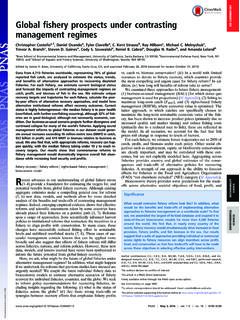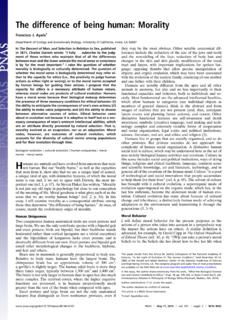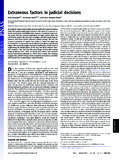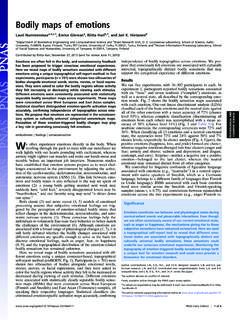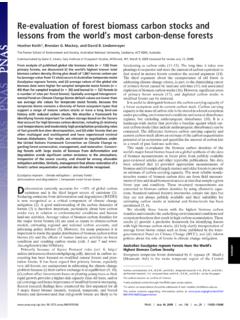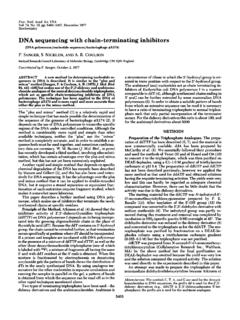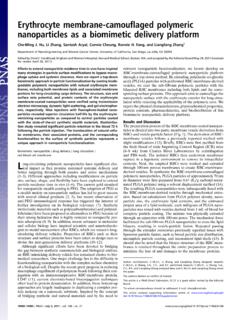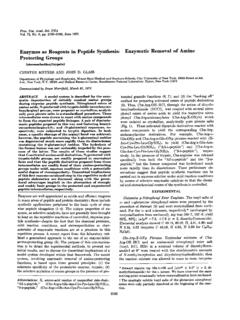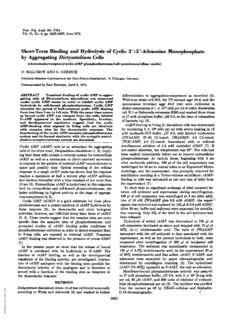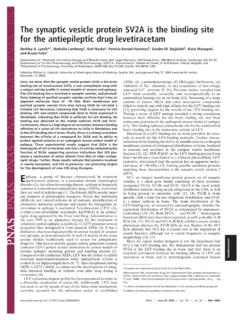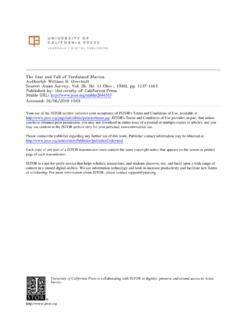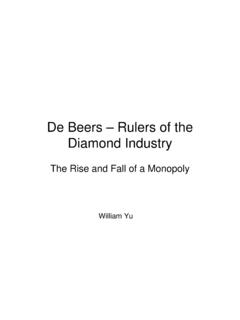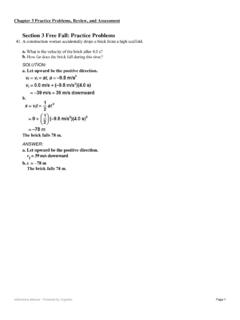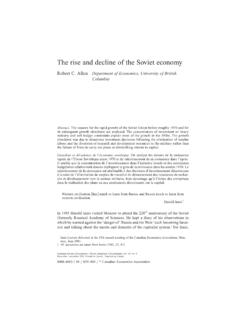Transcription of The rise and fall of rationality in language
1 The rise and fall of rationality in languageMarten Scheffera,1, Ingrid van de Leemputa, Els Weinansa,b, and Johan Bollenc,1aDepartment of Environmental Sciences, Wageningen University, 6700 AA Wageningen, The Netherlands;bDepartment of Industrial Engineering andInnovation Sciences, Eindhoven University of Technology, 5600 MB Eindhoven, The Netherlands; andcDepartment of Informatics, Cognitive Science Program,Indiana University, Bloomington, IN 47408 Contributed by Marten Scheffer; received May 29, 2021; accepted November 2, 2021; reviewed by Simon DeDeo, Maximilian Schich, and Peter SlootThe surge of post-truth political argumentation suggests that weare living in a special historical period when it comes to the bal-ance between emotion and reasoning. To explore if this is indeedthe case, we analyze language in millions of books covering theperiod from 1850 to 2019 represented in Google nGram data. Weshow that the use of words associated with rationality , such as determine and conclusion, rose systematically after 1850,while words related to human experience such as feel and believe declined.
2 This pattern reversed over the past decades,paralleled by a shift from a collectivistic to an individualistic focusas reflected, among other things, by the ratio of singular to pluralpronouns such as I / we and he / they. Interpreting this syn-chronous sea change in book language remains challenging. How-ever, as we show, the nature of this reversal occurs infiction aswell as nonfiction. Moreover, the pattern of change in the ratiobetween sentiment and rationalityflag words since 1850 alsooccurs inNew York Timesarticles, suggesting that it is not an arti-fact of the book corpora we analyzed. Finally, we show that wordtrends in books parallel trends in corresponding Google searchterms, supporting the idea that changes in book language do inpart reflect changes in interest. All in all, our results suggest thatover the past decades, there has been a marked shift in publicinterest from the collective to the individual, and from rationalitytoward post-truth era where feelings trump facts (1) may seemspecial when it comes to the historical balance between emo-tion and reasoning.
3 However, quantifying this intuitive notionremains difficult as systematic surveys of public sentiment andworldviews do not have a very long history. We address this gapby systematically analyzing word use in millions of books inEnglish and Spanish covering the period from 1850 to 2019 (2).Reading this amount of text would take a single person millennia,but computational analyses of trends in relative word frequenciesmay hint at aspects of cultural change (2 4). Print culture isselective and cannot be interpreted as a straightforward reflectionof culture in a broader sense (5). Also, the popularity of particu-lar words and phrases in a language can change for many reasonsincluding technological context ( ,carriageorcomputer), andthemeaningofsomewordscanchangeprofoun dlyovertime( ,gay) (6). Nonetheless, across large amounts of words, pat-terns of change in frequencies may to some degree reflectchanges in the way people feel and see the world (2 4), assumingthat concepts that are more abundantly referred to in books inpart represent concepts that readers at that time were moreinterested in.
4 Here, we systematically analyze long-term dynamicsin the frequency of the 5,000 most used words in English andSpanish (7) in search of indicators of changing world views. Wealso analyze patterns in fiction and nonfiction separately. More-over, we compare patterns for selected key words in other lan-guages to gauge the robustness and generalizability of our see if results might be specific to the corpora of book languagewe used, we analyzed how word use changed in theNew YorkTimessince 1850. In addition, to probe whether changes in thefrequency of words used in books does indeed reflect interest inthe corresponding concepts we analyzed how change in Googleword searches relates to the recent change in words used inbooks. Following best-practice guidelines (8) we standardizedword frequencies by dividing them by the frequency of the word an, which is indicative of total text volume, and subsequentlytaking z-scores (SI Appendix,sections1,5,and8).Principal Components of ChangeAnalyzing language change can imply the risk of , as a first unbiased exploration, we perform a principalcomponent analysis (PCA) on the z-scores of relative word fre-quencies in books over time (SI Appendix,section2).
5 Thisapproach seeks to capture patterns of change in a large datasetwithout relying on prior assumptions or search images. In bothSpanish and English, the first principal component (PC1) corre-sponds to a monotonic trend over time. The second principalcomponent (PC2) shows an asymmetric U-curve, or tiltedhockeystick, declining gradually since the industrial revolutionand surging sharply in recent decades (Fig. 1, first column). Exami-nation of the words that score highly on opposite ends of eitherprincipal component axis (Table 1 andSI Appendix,section10)suggests that in both English and Spanish the monotonic axis cap-tures general trends of word popularity over time. On the highend (representing earlier times) we find more archaic terms suchascivilized,ox,straw,savage,carriage ,andsheriff. On the low end(corresponding to more recent times) we find words such ascola,product,ski,allergic,tech,anddumm y. By contrast, the tilted hock-eystick axes are dominated on the high side (more recently) bywords reflecting concepts related to personal experience such assenses, spirituality, emotions, and personal relationships as detailedSignificanceThe post-truth era has taken many by surprise.
6 Here, we usemassive language analysis to demonstrate that the rise of fact-free argumentation may perhaps be understood as part of adeeper change. After the year 1850, the use of sentiment-laden words in Google Books declined systematically, whilethe use of words associated with fact-based argumentationrose steadily. This pattern reversed in the 1980s, and thischange accelerated around 2007, when across languages, thefrequency of fact-related words dropped while emotion-ladenlanguage surged, a trend paralleled by a shift from collectivisticto individualistic contributions: , , , and designed research; , , performed research; and analyzed data; and , , , wrote the : , Carnegie Mellon University; , Tallinna Ulikool; and ,Universiteit van authors declare no competing open access article is distributed underCreative Commons Attribution License (CC BY).See onlinefor related content such as whom correspondence may be addressed.
7 Email: article contains supporting information online December 16, Vol. 118 No. 51 e2107848118 ANDCOGNITIVE SCIENCESD ownloaded by guest on February 5, 2022 later (Table 1). By contrast, the opposite end of this axis has wordsrelated to society including words associated with science, rationaldecision-making, procedures, and systems (Table 1).Sentiment TrendsAs a next objective step, we analyzed changes in the relativefrequencies of words that have been independently assessed asindicators of different aspects of emotion (using the ANEW[Affective Norms for English Words] lexicon) ( 9) and a compa-rable lexicon for Spanish (seeSI Appendix, section 3). Valence or pleasantness associated with a word is a dominantaspect of many models of human emotion. ANEW valencevalues range from low ( , for words such astorture,rape,ter-rorism) to high ( , words such asvacation,enjoyment,free).Some models of human emotions also include an orthogonalaffective dimension of arousal, which can be evoked by wordsgoing from low arousal ( ,dull,scene,asleep) to high arousal( ,rampage,sex,tornado).
8 Integrating frequency-weightedvalence and arousal sentiment scores for all words from our setof 5,000 that were listed in the sentiment lexicons we arrive atan index of positive and negative sentiment as well as arousalfor the entire content of books published each year since both English and Spanish we find patterns of these affectiveindicators that closely resemble the hockeystick patterns of thePCA (Fig. 1, second column andSI Appendix, Table S1).Principal ComponentEnglish AllASentimentBIntuition related wordsCRationality related wordsDSpanishEFGHE nglish FictionIJKL18501875190019251950197520002 025yearEnglish excl FictionM18501875190019251950197520002025 yearN18501875190019251950197520002025yea rO18501875190019251950197520002025yearPF ig. of four characteristics of English and Spanish book language represented in Google n-gram data. (A,E,I,andM) Second principal compo-nent of change in z-scores of frequencies of the 5,000 most-used words. (B,F,J, andN) Relative level of arousal (black), positive sentiment (blue), and nega-tive sentiment (red).
9 (C,G,K,andO) Z-scores of frequencies offlag-words related to intuition, believing, spirituality, sapience:spirit,imagine,wisdom,wise,hunc h,mind,suspicion,believe,think,trust,fai th,truth,true,belief,doubt,hope,fear,lif e,soul,heaven,eternal,mortal,holy,god,pr ay,mystery,sense,feel,soft,hard,cold,hot ,smell,foul,taste,sweet,bi tter,hear,sound,silence,loud,see,light,d ark,bright(for Spanish:esp ritu,imaginar,sabidur a,mente,sospecha,creer,pensar,fe,verdad, duda,esperanza,miedo,vida,alma,cielo,san to,dios,misterio,sentido,sensaci on,sentir,suave,duro,fr o,caliente,gusto,dulce,o r,silencio,fuerte,ver,mirar,oscuro,brill ante). The black central line represents the mean and the gray shaded area the 95% confide nceinterval of the mean. (D,H,L,andP)Similarbutforflag words related to rationality , science, and quantification:science,technology,scient ific,chemistry,chemicals,physics,medicin e,model,method,fact,data,math,analysis,c onclusion,limit,result,determine,transmi ssion,assuming,system,size,unit,pres-sur e,area,percent(for Spanish:ciencia,tecnolog a,cient fico,qu mica,productos,f sica,medicina,modelo,m etodo,dato,datos,hip otesis,estad sticas,c alculo,an alisis,conclusi on,l mite,resultado,determinar,transmisi on,sistema,tama~no,unidad,presi on, area,densidad,porcentaje).
10 2of8jPNASS cheffer et rise and fall of rationality in languageDownloaded by guest on February 5, 2022 Correlated ConceptsAlthough sentiment analysis allows a meaningful evaluation ofthe affective components of language change, sentiment indica-tors do not necessarily capture the full essence of the seachange revealed by the PCA. This becomes evident if we exam-ine the words correlating and anticorrelating most strongly tothe PCA axis, to the sentiment score, and to the overall hockey-stick pattern. Lists of the 5% top-scoring words are given inSIAppendix, section 10), but a glance at the 1% top-scoring wordsfor English already reveals that the patterns we find correspondto a seesaw between two opposing poles of concepts (Table 1).On the one hand we have words that may be broadly character-ized as related to a personal view of the world (Table 1, toprow). At the contrasting end there are words that could becharacterized at first glance as related to societal systems (Table1, bottom row).
